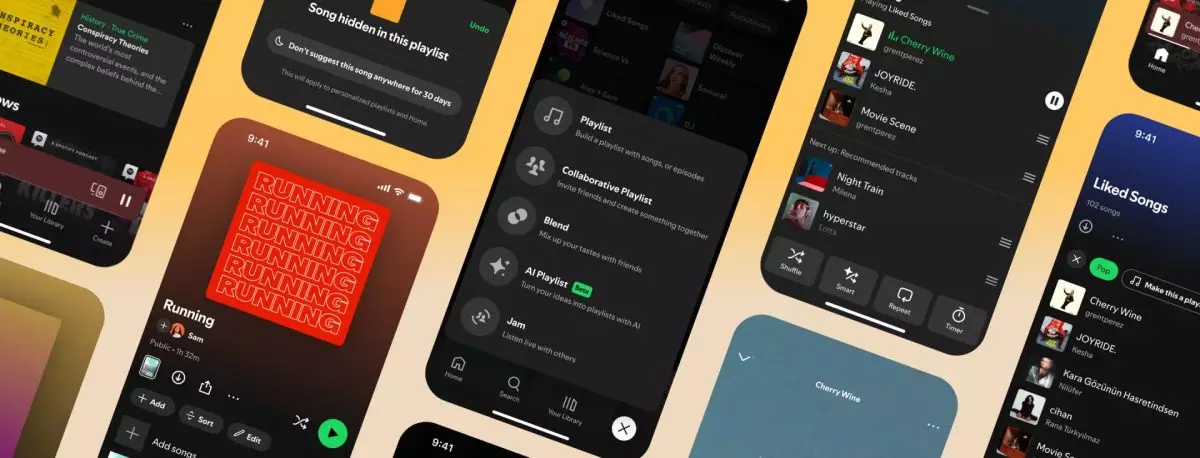Spotify’s recent update claims to revolutionize the way users interact with their beloved platform. In a music application that often leans heavily on algorithm-driven suggestions, this refresh introduces a beacon of hope for users seeking more personalization. Spotify aims to put the control back in the hands of its subscribers, allowing them to tailor their listening experiences effectively. This update consists of various features encouraging users to dictate the music they want to hear and when they want to hear it—far from the passive consumption often associated with algorithmic curation.
Redefining the Queue: Empowering Premium Subscribers
One of the most significant changes for Premium users is the complete revamp of the Queue system. Spotify’s new design improves ease of use by prominently featuring essential controls such as Shuffle, Smart Shuffle, and Repeat. The ease with which users can manage their music queue indicates a shift toward recognizing user preferences over algorithmic demands. The inclusion of a Sleep Timer feature, allowing users to set a duration for music playback, demonstrates a thoughtful approach to listening, giving users agency over their auditory environments.
Moreover, the new functionality of previewing tracks recommended by Spotify for play after the current Queue enhances user control even further. This proactive feature allows listeners to curate their musical experience and make informed decisions about their auditory journey, creating a more engaging interaction with the app. By giving users the option to explicitly select or deselect songs before they even get played, Spotify effectively transforms what could be a passive listening experience into an active, user-centric one.
An Intuitive Approach to Playlist Management
The introduction of a streamlined approach to playlist management is another notable aspect of the update. Spotify now makes it easier for users to manipulate their playlists directly from their mobile devices with conveniently placed Add, Sort, and Edit buttons. This layer of user customization is essential for avid listeners who invest time in crafting their ideal playlists; they want simplicity without sacrificing quality.
Another remarkable feature rolled out is the ability to create new playlists from the user’s Liked songs, filtered by genre. This functionality empowers users to explore their preferences and curate playlists based on their specific musical tastes, thereby enhancing engagement. It eases the often tedious process of going through songs and significantly increases the joy of music discovery.
The Hide and Snooze Functions: Tailored Listening Experience
One of the more innovative features introduced in this update is the enhanced “Hide” button, now strategically placed for user convenience. This allows listeners to bypass songs they aren’t inclined to hear with a simple tap. Furthermore, the introduction of the 30-day Snooze feature strengthens this capability by providing a temporary yet effective measure to manage song recommendations without backlash. This approach not only demonstrates Spotify’s consideration of user preferences but also their commitment to refining the listening experience as personal and unique.
Collaborative Features Taking Center Stage
In the spirit of connection and community, Spotify also introduced collaborative features, like the real-time Jam function, allowing multiple users to contribute to a shared Queue. This is a pivotal feature for groups of friends or families who enjoy music together. By integrating social interaction into the app, Spotify recognizes the importance of community in the music experience, thereby enriching its platform beyond just listening to tracks alone.
Additionally, the location of the Your Library tab has been strategically adjusted to enhance usability, further underscoring Spotify’s commitment to creating an intuitive app tailored to its users’ needs. The meticulous enhancements show Spotify’s willingness to adapt and evolve, making music listening a genuinely engaging and personalized experience.
Spotify’s vision of a user-centered app is not only revolutionary but also reflective of a broader trend in digital service provision: reshaping algorithms to prioritize user experience. By fostering a culture where personalization is paramount, Spotify sets a new standard for music applications, reimagining how we engage with music in an increasingly digital world.

